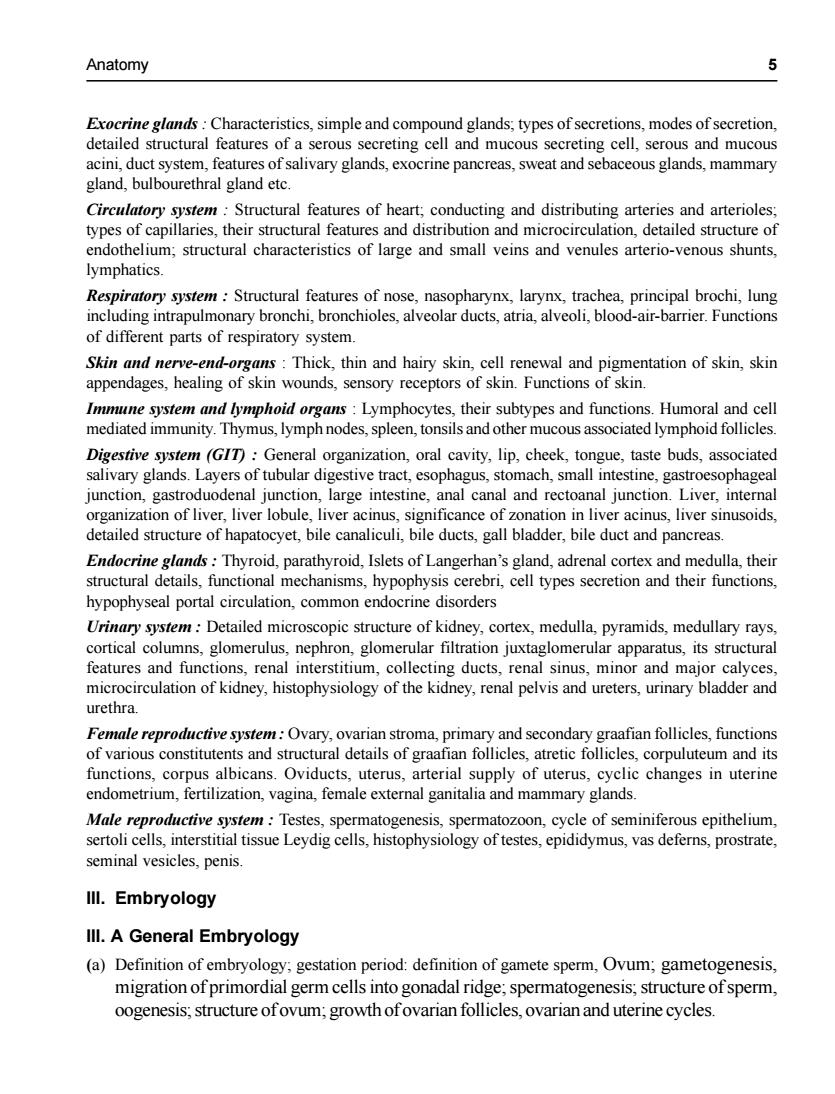
5AnatomyExocrineglands :Characteristics, simpleand compound glands;types of secretions,modes ofsecretion,detailed structural features of a serous secreting cell and mucous secreting cell, serous and mucousacini, duct system,features of salivaryglands, exocrine pancreas, sweat and sebaceous glands, mammarygland,bulbourethral gland etc.Circulatory system: Structural features of heart, conducting and distributing arteries and arterioles:types of capillaries, their structural features and distribution and microcirculation, detailed structure ofendothelium; structural characteristics of large and small veins and venules arterio-venous shunts,lymphatics.Respiratory system : Structural features of nose, nasopharynx, larynx, trachea, principal brochi, lungincluding intrapulmonary bronchi, bronchioles,alveolar ducts,atria,alveoli, blood-air-barrier.Functionsofdifferentpartsofrespiratorysystem.Skin and nerve-end-organs : Thick, thin and hairy skin, cell renewal and pigmentation of skin, skinappendages, healing of skin wounds, sensory receptors of skin.Functions of skin.Immune system and lymphoid organs :Lymphocytes, their subtypes and functions.Humoral and cellmediated immunity.Thymus, lymph nodes, spleen,tonsils and other mucous associated lymphoidfolliclesDigestive system (GIT) : General organization, oral cavity, lip, cheek, tongue, taste buds, associatedsalivary glands. Layers of tubular digestive tract, esophagus, stomach, small intestine, gastroesophagealjunction,gastroduodenal junction, large intestine, anal canal and rectoanal junction.Liver, internalorganization of liver, liver lobule, liver acinus, significance of zonation in liver acinus, liver sinusoids,detailed structure of hapatocyet, bile canaliculi, bile ducts,gall bladder, bileduct and pancreas.Endocrine glands :Thyroid,parathyroid, Islets ofLangerhan's gland, adrenal cortex and medulla, theirstructural details, functional mechanisms, hypophysis cerebri, cell types secretion and their functions,hypophysealportal circulation,commonendocrinedisordersUrinary system: Detailed microscopic structure ofkidney, cortex, medulla, pyramids, medullary rays,cortical columns,glomerulus,nephron,glomerularfiltration juxtaglomerular apparatus,its structuralfeatures and functions, renal interstitium, collecting ducts, renal sinus, minor and major calyces,microcirculation of kidney,histophysiology of thekidney,renal pelvis and ureters, urinary bladder andurethra.Femalereproductivesystem:Ovary,ovarian stroma,primaryandsecondarygraafianfollicles,functionsof various constitutents and structural details of graafianfollicles,atreticfollicles, corpuluteum and itsfunctions,corpus albicans.Oviducts,uterus,arterial supply ofuterus, cyclic changes in uterineendometrium,fertilization,vagina,female external ganitalia and mammaryglands.Male reproductive system:Testes, spermatogenesis, spermatozoon, cycle of seminiferous epithelium,sertoli cells, interstitial tissue Leydig cells, histophysiology oftestes, epididymus, vas deferns, prostrate,seminal vesicles,penis.Il.EmbryologyIll.AGeneral Embryology(a)Definition of embryology,gestation period:definition of gamete sperm, Ovum,gametogenesis,migration of primordial germ cells into gonadal ridge, spermatogenesis; structure of sperm,oogenesis; structure ofovum, growth ofovarian follicles, ovarian and uterine cycles
Anatomy 5 Exocrine glands : Characteristics, simple and compound glands; types of secretions, modes of secretion, detailed structural features of a serous secreting cell and mucous secreting cell, serous and mucous acini, duct system, features of salivary glands, exocrine pancreas, sweat and sebaceous glands, mammary gland, bulbourethral gland etc. Circulatory system : Structural features of heart; conducting and distributing arteries and arterioles; types of capillaries, their structural features and distribution and microcirculation, detailed structure of endothelium; structural characteristics of large and small veins and venules arterio-venous shunts, lymphatics. Respiratory system : Structural features of nose, nasopharynx, larynx, trachea, principal brochi, lung including intrapulmonary bronchi, bronchioles, alveolar ducts, atria, alveoli, blood-air-barrier. Functions of different parts of respiratory system. Skin and nerve-end-organs : Thick, thin and hairy skin, cell renewal and pigmentation of skin, skin appendages, healing of skin wounds, sensory receptors of skin. Functions of skin. Immune system and lymphoid organs : Lymphocytes, their subtypes and functions. Humoral and cell mediated immunity. Thymus, lymph nodes, spleen, tonsils and other mucous associated lymphoid follicles. Digestive system (GIT) : General organization, oral cavity, lip, cheek, tongue, taste buds, associated salivary glands. Layers of tubular digestive tract, esophagus, stomach, small intestine, gastroesophageal junction, gastroduodenal junction, large intestine, anal canal and rectoanal junction. Liver, internal organization of liver, liver lobule, liver acinus, significance of zonation in liver acinus, liver sinusoids, detailed structure of hapatocyet, bile canaliculi, bile ducts, gall bladder, bile duct and pancreas. Endocrine glands : Thyroid, parathyroid, Islets of Langerhan’s gland, adrenal cortex and medulla, their structural details, functional mechanisms, hypophysis cerebri, cell types secretion and their functions, hypophyseal portal circulation, common endocrine disorders Urinary system : Detailed microscopic structure of kidney, cortex, medulla, pyramids, medullary rays, cortical columns, glomerulus, nephron, glomerular filtration juxtaglomerular apparatus, its structural features and functions, renal interstitium, collecting ducts, renal sinus, minor and major calyces, microcirculation of kidney, histophysiology of the kidney, renal pelvis and ureters, urinary bladder and urethra. Female reproductive system : Ovary, ovarian stroma, primary and secondary graafian follicles, functions of various constitutents and structural details of graafian follicles, atretic follicles, corpuluteum and its functions, corpus albicans. Oviducts, uterus, arterial supply of uterus, cyclic changes in uterine endometrium, fertilization, vagina, female external ganitalia and mammary glands. Male reproductive system : Testes, spermatogenesis, spermatozoon, cycle of seminiferous epithelium, sertoli cells, interstitial tissue Leydig cells, histophysiology of testes, epididymus, vas deferns, prostrate, seminal vesicles, penis. III. Embryology III. A General Embryology (a) Definition of embryology; gestation period: definition of gamete sperm, Ovum; gametogenesis, migration of primordial germ cells into gonadal ridge; spermatogenesis; structure of sperm, oogenesis; structure of ovum; growth of ovarian follicles, ovarian and uterine cycles
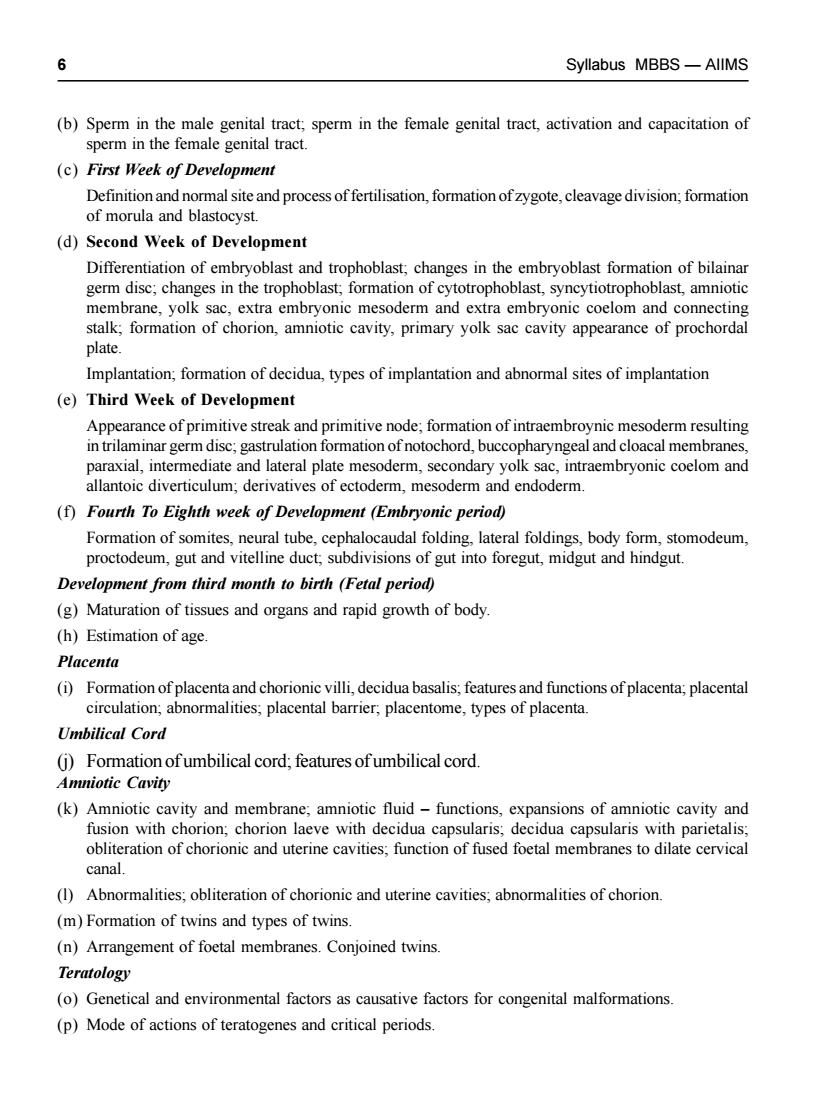
6Syllabus MBBS—AIIMS(b) Sperm in the male genital tract, sperm in the female genital tract, activation and capacitation ofsperm in thefemale genital tract.(c)First Week of DevelopmentDefinitionand normal siteandprocess offertilisation,formationofzygote,cleavagedivision,formationof morulaand blastocyst.(d)Second WeekofDevelopmentDifferentiation of embryoblast and trophoblast,changes inthe embryoblastformationof bilainargerm discchanges in thetrophoblast;formation of cytotrophoblast,syncytiotrophoblast,amnioticmembrane, yolk sac, extra embryonic mesoderm and extra embryonic coelom and connectingstalk,formationof chorion,amniotic cavity,primaryyolk sac cavity appearanceof prochordalplateImplantation,formation ofdecidua,typesofimplantation and abnormal sites ofimplantation(e)ThirdWeek ofDevelopmentAppearance of primitive streak and primitive node; formation of intraembroynic mesoderm resultingintrilaminargermdisc,gastrulationformationofnotochord,buccopharyngealandcloacalmembranesparaxial, intermediate and lateral platemesoderm,secondary yolk sac,intraembryonic coelom andallantoic diverticulum; derivatives of ectoderm,mesoderm and endoderm.(f) Fourth ToEighth weekof Development (Embryonicperiod)Formation of somites,neural tube, cephalocaudal folding,lateralfoldings,bodyform, stomodeum,proctodeum, gut and vitelline duct, subdivisions of gut into foregut, midgut and hindgut.Development from third month to birth (Fetal period)(g)Maturationof tissues andorgans andrapid growthof body(h)EstimationofagePlacenta(i)Formation ofplacenta andchorionicvilli,decidua basalisfeatures andfunctionsofplacenta,placentalcirculation,abnormalities,placentalbarrier,placentome,typesofplacenta.UmbilicalCord)Formation ofumbilical cord; features ofumbilical cordAmniotic Cavity(k)Amniotic cavityand membrane; amniotic fluid-functions, expansions of amniotic cavity andfusion with chorion, chorion laeve with decidua capsularis, decidua capsularis with parietalisobliteration of chorionic and uterine cavities; function of fused foetal membranes to dilate cervicalcanal.()Abnormalities;obliterationof chorionic anduterinecavities;abnormalities of chorion.(m)Formationoftwinsandtypesoftwins(n)Arrangement of foetal membranes.Conjoined twins.Teratology(o)Genetical and environmental factors as causative factors for congenital malformations.(p)Modeofactionsofteratogenesandcriticalperiods
6 Syllabus MBBS — AIIMS (b) Sperm in the male genital tract; sperm in the female genital tract, activation and capacitation of sperm in the female genital tract. (c) First Week of Development Definition and normal site and process of fertilisation, formation of zygote, cleavage division; formation of morula and blastocyst. (d) Second Week of Development Differentiation of embryoblast and trophoblast; changes in the embryoblast formation of bilainar germ disc; changes in the trophoblast; formation of cytotrophoblast, syncytiotrophoblast, amniotic membrane, yolk sac, extra embryonic mesoderm and extra embryonic coelom and connecting stalk; formation of chorion, amniotic cavity, primary yolk sac cavity appearance of prochordal plate. Implantation; formation of decidua, types of implantation and abnormal sites of implantation (e) Third Week of Development Appearance of primitive streak and primitive node; formation of intraembroynic mesoderm resulting in trilaminar germ disc; gastrulation formation of notochord, buccopharyngeal and cloacal membranes, paraxial, intermediate and lateral plate mesoderm, secondary yolk sac, intraembryonic coelom and allantoic diverticulum; derivatives of ectoderm, mesoderm and endoderm. (f) Fourth To Eighth week of Development (Embryonic period) Formation of somites, neural tube, cephalocaudal folding, lateral foldings, body form, stomodeum, proctodeum, gut and vitelline duct; subdivisions of gut into foregut, midgut and hindgut. Development from third month to birth (Fetal period) (g) Maturation of tissues and organs and rapid growth of body. (h) Estimation of age. Placenta (i) Formation of placenta and chorionic villi, decidua basalis; features and functions of placenta; placental circulation; abnormalities; placental barrier; placentome, types of placenta. Umbilical Cord (j) Formation of umbilical cord; features of umbilical cord. Amniotic Cavity (k) Amniotic cavity and membrane; amniotic fluid – functions, expansions of amniotic cavity and fusion with chorion; chorion laeve with decidua capsularis; decidua capsularis with parietalis; obliteration of chorionic and uterine cavities; function of fused foetal membranes to dilate cervical canal. (l) Abnormalities; obliteration of chorionic and uterine cavities; abnormalities of chorion. (m) Formation of twins and types of twins. (n) Arrangement of foetal membranes. Conjoined twins. Teratology (o) Genetical and environmental factors as causative factors for congenital malformations. (p) Mode of actions of teratogenes and critical periods
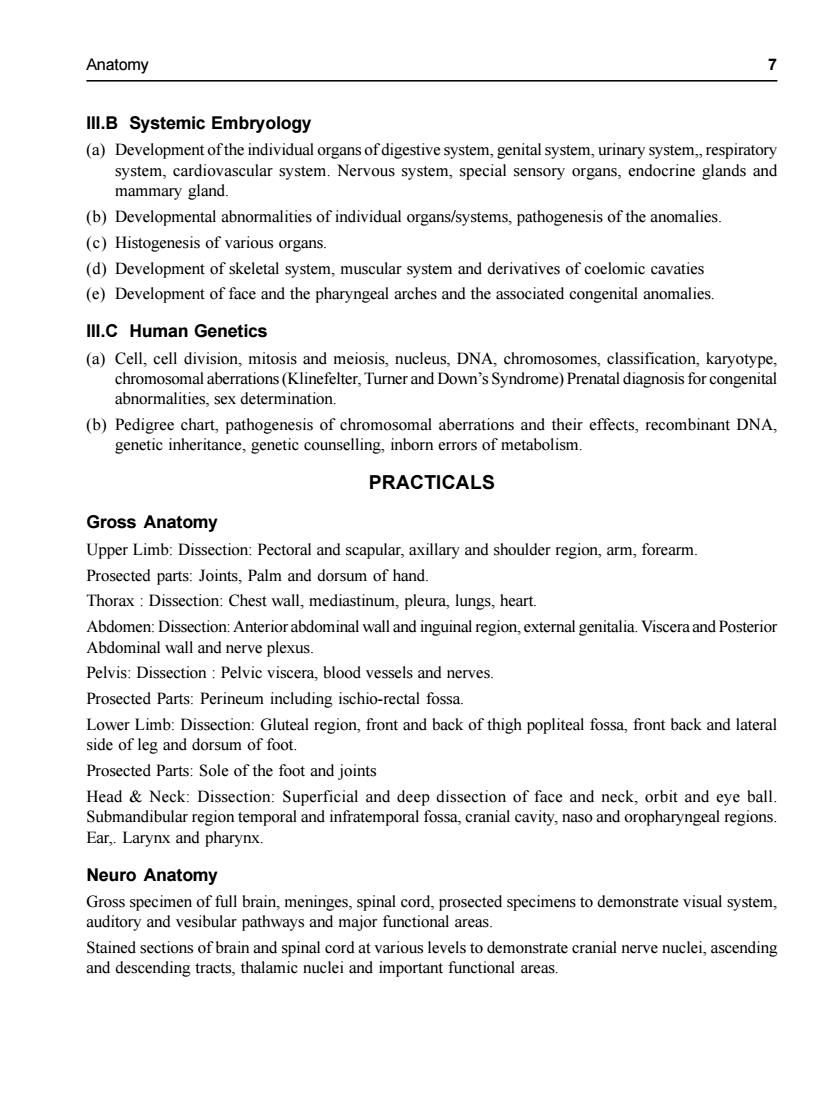
7AnatomyII.B SystemicEmbryology(a)Developmentoftheindividualorgansofdigestivesystem,genitalsystem,urinarysystem,respiratorysystem, cardiovascular system. Nervous system, special sensory organs, endocrine glands andmammary gland.(b)Developmental abnormalitiesofindividual organs/systems,pathogenesisoftheanomalies.(c) Histogenesis of various organs.(d) Development of skeletal system, muscular system and derivatives of coelomic cavaties(e)Development offace and thepharyngeal arches and theassociated congenital anomalies.III.CHumanGenetics(a) Cell, cell division, mitosis and meiosis, nucleus, DNA, chromosomes, classification, karyotype,chromosomalaberrations (Klinefelter,Turnerand Down's Syndrome)Prenatal diagnosisfor congenitalabnormalities,sexdetermination.(b) Pedigree chart, pathogenesis of chromosomal aberrations and their effects, recombinant DNA,genetic inheritance, genetic counselling, inborn errors of metabolism.PRACTICALSGrossAnatomyUpper Limb:Dissection:Pectoral and scapular, axillary and shoulder region, arm,forearm.Prosectedparts:Joints,Palmanddorsumof handThorax :Dissection: Chest wall, mediastinum, pleura, lungs, heart.Abdomen: Dissection: Anterior abdominal wall and inguinal region,external genitalia. Viscera and PosteriorAbdominal wall and nerveplexus.Pelvis:Dissection:Pelvicviscera,bloodvesselsandnerves.Prosected Parts: Perineum including ischio-rectal fossa.Lower Limb: Dissection: Gluteal region, front and back of thigh popliteal fossa, front back and lateralside of leg and dorsum of foot.Prosected Parts: Sole of the foot and jointsHead & Neck: Dissection: Superficial and deep dissection of face and neck, orbit and eye ballSubmandibularregiontemporal andinfratemporalfossa,cranial cavity,nasoandoropharyngeal regions.Ear, Larynx and pharynx.Neuro AnatomyGross specimen offull brain,meninges,spinal cord,prosectedspecimenstodemonstratevisual system,auditory and vesibular pathways and major functional areas.Stained sections of brain and spinal cord at various levels to demonstrate cranial nerve nuclei, ascendingand descendingtracts,thalamic nuclei and importantfunctional areas
Anatomy 7 III.B Systemic Embryology (a) Development of the individual organs of digestive system, genital system, urinary system, respiratory system, cardiovascular system. Nervous system, special sensory organs, endocrine glands and mammary gland. (b) Developmental abnormalities of individual organs/systems, pathogenesis of the anomalies. (c) Histogenesis of various organs. (d) Development of skeletal system, muscular system and derivatives of coelomic cavaties (e) Development of face and the pharyngeal arches and the associated congenital anomalies. III.C Human Genetics (a) Cell, cell division, mitosis and meiosis, nucleus, DNA, chromosomes, classification, karyotype, chromosomal aberrations (Klinefelter, Turner and Down’s Syndrome) Prenatal diagnosis for congenital abnormalities, sex determination. (b) Pedigree chart, pathogenesis of chromosomal aberrations and their effects, recombinant DNA, genetic inheritance, genetic counselling, inborn errors of metabolism. PRACTICALS Gross Anatomy Upper Limb: Dissection: Pectoral and scapular, axillary and shoulder region, arm, forearm. Prosected parts: Joints, Palm and dorsum of hand. Thorax : Dissection: Chest wall, mediastinum, pleura, lungs, heart. Abdomen: Dissection: Anterior abdominal wall and inguinal region, external genitalia. Viscera and Posterior Abdominal wall and nerve plexus. Pelvis: Dissection : Pelvic viscera, blood vessels and nerves. Prosected Parts: Perineum including ischio-rectal fossa. Lower Limb: Dissection: Gluteal region, front and back of thigh popliteal fossa, front back and lateral side of leg and dorsum of foot. Prosected Parts: Sole of the foot and joints Head & Neck: Dissection: Superficial and deep dissection of face and neck, orbit and eye ball. Submandibular region temporal and infratemporal fossa, cranial cavity, naso and oropharyngeal regions. Ear,. Larynx and pharynx. Neuro Anatomy Gross specimen of full brain, meninges, spinal cord, prosected specimens to demonstrate visual system, auditory and vesibular pathways and major functional areas. Stained sections of brain and spinal cord at various levels to demonstrate cranial nerve nuclei, ascending and descending tracts, thalamic nuclei and important functional areas
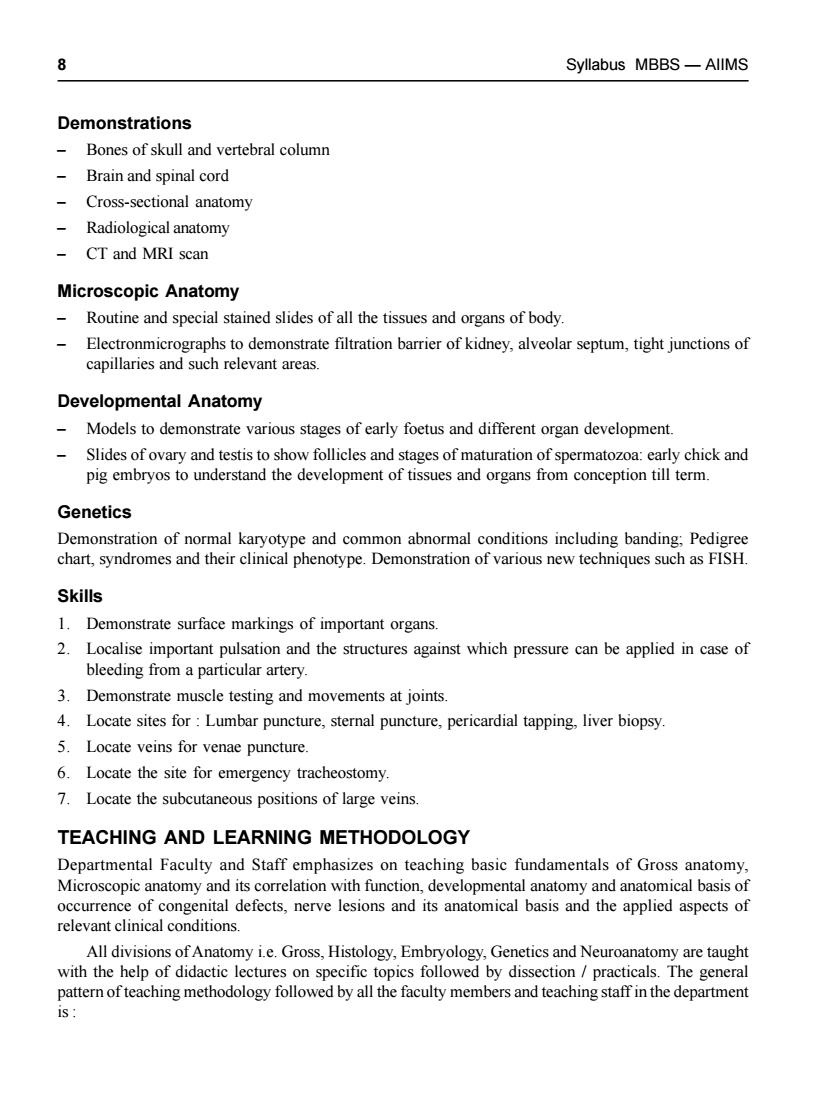
8Syllabus MBBS—AIIMSDemonstrationsBonesofskullandvertebral columnBrain and spinal cordCross-sectional anatomy-Radiological anatomyCT and MRI scanMicroscopicAnatomyRoutineand special stained slidesof all thetissuesand organsof bodyElectronmicrographstodemonstratefiltration barrierofkidney,alveolar septum,tight junctionsofcapillaries and such relevant areas.DevelopmentalAnatomyModels to demonstrate various stages of early foetus and different organ development.Slides of ovary and testis to showfollicles and stages of maturation of spermatozoa: early chick andpig embryos to understand the development of tissues and organs from conception till term.GeneticsDemonstration of normal karyotype and common abnormal conditions including banding,Pedigreechart,syndromes and their clinical phenotype.Demonstrationof variousnewtechniques such asFISH.Skills1.Demonstrate surfacemarkings of important organs2. Localise important pulsation and the structures against which pressure can be applied in case ofbleeding from a particular artery.3. Demonstratemuscletestingand movements at joints.4.Locate sites for:Lumbar puncture, sternal puncture,pericardial tapping,liver biopsy5.Locateveinsforvenaepuncture.6.Locatethesiteforemergencytracheostomy7.Locatethesubcutaneous positions of largeveins.TEACHINGANDLEARNINGMETHODOLOGYDepartmental Faculty and Staff emphasizes on teaching basic fundamentals of Gross anatomy.Microscopicanatomyand itscorrelationwithfunction,developmental anatomyandanatomical basisofoccurrence of congenital defects,nerve lesions and its anatomical basis and the applied aspects ofrelevant clinical conditions.All divisions of Anatomy i.e.Gross, Histology,Embryology, Genetics and Neuroanatomy are taughtwith the help of didactic lectures on specific topics followed by dissection / practicals. The generalpatternofteachingmethodologyfollowed byallthefacultymembers andteachingstaff inthedepartmentis :
8 Syllabus MBBS — AIIMS Demonstrations – Bones of skull and vertebral column – Brain and spinal cord – Cross-sectional anatomy – Radiological anatomy – CT and MRI scan Microscopic Anatomy – Routine and special stained slides of all the tissues and organs of body. – Electronmicrographs to demonstrate filtration barrier of kidney, alveolar septum, tight junctions of capillaries and such relevant areas. Developmental Anatomy – Models to demonstrate various stages of early foetus and different organ development. – Slides of ovary and testis to show follicles and stages of maturation of spermatozoa: early chick and pig embryos to understand the development of tissues and organs from conception till term. Genetics Demonstration of normal karyotype and common abnormal conditions including banding; Pedigree chart, syndromes and their clinical phenotype. Demonstration of various new techniques such as FISH. Skills 1. Demonstrate surface markings of important organs. 2. Localise important pulsation and the structures against which pressure can be applied in case of bleeding from a particular artery. 3. Demonstrate muscle testing and movements at joints. 4. Locate sites for : Lumbar puncture, sternal puncture, pericardial tapping, liver biopsy. 5. Locate veins for venae puncture. 6. Locate the site for emergency tracheostomy. 7. Locate the subcutaneous positions of large veins. TEACHING AND LEARNING METHODOLOGY Departmental Faculty and Staff emphasizes on teaching basic fundamentals of Gross anatomy, Microscopic anatomy and its correlation with function, developmental anatomy and anatomical basis of occurrence of congenital defects, nerve lesions and its anatomical basis and the applied aspects of relevant clinical conditions. All divisions of Anatomy i.e. Gross, Histology, Embryology, Genetics and Neuroanatomy are taught with the help of didactic lectures on specific topics followed by dissection / practicals. The general pattern of teaching methodology followed by all the faculty members and teaching staff in the department is :
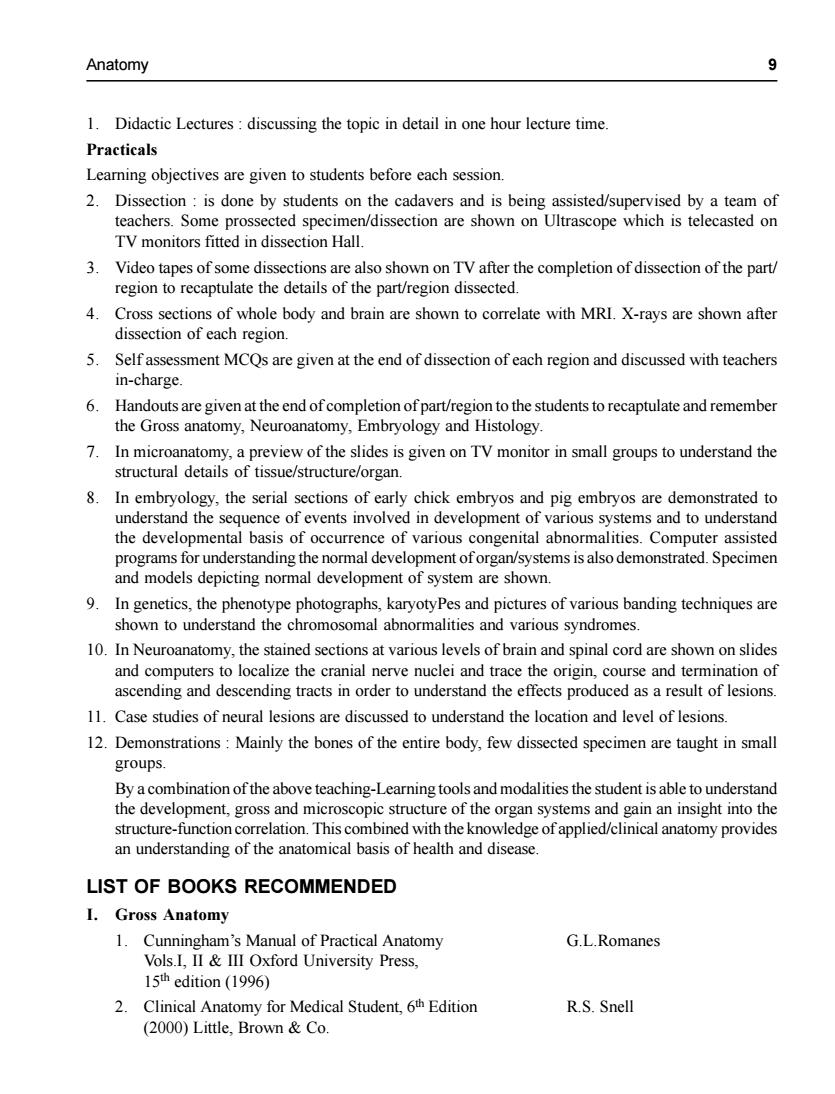
9Anatomy1.Didactic Lectures :discussing the topic in detail in one hour lecture time.PracticalsLearning objectives aregiven to studentsbefore each session.2.Dissection :is done by students on the cadavers and is being assisted/supervised by a team ofteachers.Someprossected specimen/dissection are shown onUltrascopewhichistelecasted onTVmonitors fitted in dissection Hall.3.Videotapesofsomedissections arealsoshownonTVafterthecompletionofdissectionof thepart/region to recaptulate the details of thepart/region dissected.4.Cross sections of wholebody and brain are shown tocorrelatewithMRI.X-rays are shown afterdissectionofeachregion.Self assessment MCQs aregiven at theend ofdissectionof each region anddiscussed with teachers5.in-charge.Handouts are given at the endofcompletion ofpart/region to the students torecaptulate and remember6.theGrossanatomy,Neuroanatomy,EmbryologyandHistology7.In microanatomy,a preview of the slides is given on TV monitor in small groups to understand thestructural details of tissue/structure/organ.8.In embryology, the serial sections of early chick embryos and pig embryos are demonstrated tounderstand the sequence of events involved in development of various systems andto understandthe developmental basis of occurrence of various congenital abnormalities.Computer assistedprogramsforunderstandingthenormal development oforgan/systems is alsodemonstrated.SpecimenandmodelsdepictingnormaldevelopmentofsystemareshownIn genetics, the phenotype photographs, karyotyPes and pictures of various banding techniques are4shown to understand the chromosomal abnormalities and various syndromes10.In Neuroanatomy,the stained sections at variouslevels of brainand spinal cord are shown on slidesand computersto localizethe cranial nerve nuclei and trace the origin,course and termination ofascending and descending tracts in order to understand the effects produced as a result of lesions.11. Case studies of neural lesions are discussed to understand the location and level of lesions.12.Demonstrations:Mainlythebones of theentirebody,few dissected specimen aretaught in smallgroups.By a combination of the above teaching-Learning tools and modalities the student is able to understandthe development, gross and microscopic structure of the organ systems and gain an insight into thestructure-function correlation.Thiscombined withtheknowledgeof applied/clinical anatomyprovidesan understanding of the anatomical basis of health and diseaseLISTOFBOOKSRECOMMENDEDI.GrossAnatomy1.Cunningham's Manual of PracticalAnatomyG.L.RomanesVols.I, II & III Oxford University Press,15th edition (1996)R.S. SnellClinical AnatomyforMedical Student,6thEdition2.(2000) Little, Brown & Co
Anatomy 9 1. Didactic Lectures : discussing the topic in detail in one hour lecture time. Practicals Learning objectives are given to students before each session. 2. Dissection : is done by students on the cadavers and is being assisted/supervised by a team of teachers. Some prossected specimen/dissection are shown on Ultrascope which is telecasted on TV monitors fitted in dissection Hall. 3. Video tapes of some dissections are also shown on TV after the completion of dissection of the part/ region to recaptulate the details of the part/region dissected. 4. Cross sections of whole body and brain are shown to correlate with MRI. X-rays are shown after dissection of each region. 5. Self assessment MCQs are given at the end of dissection of each region and discussed with teachers in-charge. 6. Handouts are given at the end of completion of part/region to the students to recaptulate and remember the Gross anatomy, Neuroanatomy, Embryology and Histology. 7. In microanatomy, a preview of the slides is given on TV monitor in small groups to understand the structural details of tissue/structure/organ. 8. In embryology, the serial sections of early chick embryos and pig embryos are demonstrated to understand the sequence of events involved in development of various systems and to understand the developmental basis of occurrence of various congenital abnormalities. Computer assisted programs for understanding the normal development of organ/systems is also demonstrated. Specimen and models depicting normal development of system are shown. 9. In genetics, the phenotype photographs, karyotyPes and pictures of various banding techniques are shown to understand the chromosomal abnormalities and various syndromes. 10. In Neuroanatomy, the stained sections at various levels of brain and spinal cord are shown on slides and computers to localize the cranial nerve nuclei and trace the origin, course and termination of ascending and descending tracts in order to understand the effects produced as a result of lesions. 11. Case studies of neural lesions are discussed to understand the location and level of lesions. 12. Demonstrations : Mainly the bones of the entire body, few dissected specimen are taught in small groups. By a combination of the above teaching-Learning tools and modalities the student is able to understand the development, gross and microscopic structure of the organ systems and gain an insight into the structure-function correlation. This combined with the knowledge of applied/clinical anatomy provides an understanding of the anatomical basis of health and disease. LIST OF BOOKS RECOMMENDED I. Gross Anatomy 1. Cunningham’s Manual of Practical Anatomy G.L.Romanes Vols.I, II & III Oxford University Press, 15th edition (1996) 2. Clinical Anatomy for Medical Student, 6th Edition R.S. Snell (2000) Little, Brown & Co